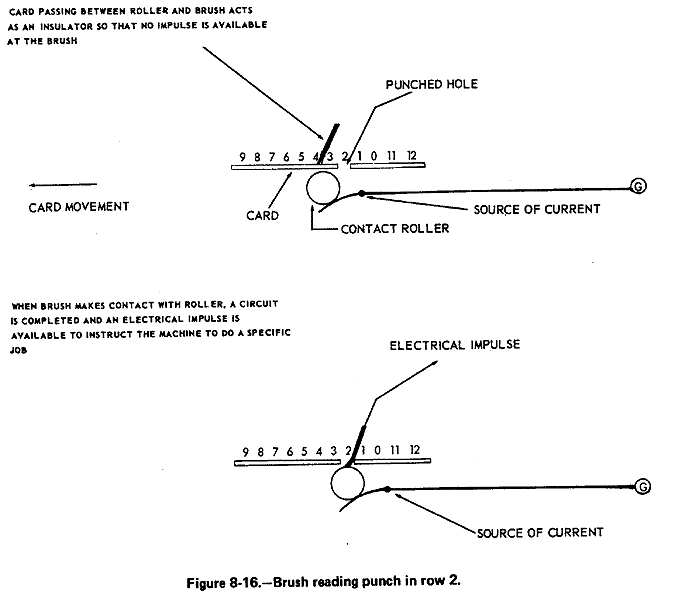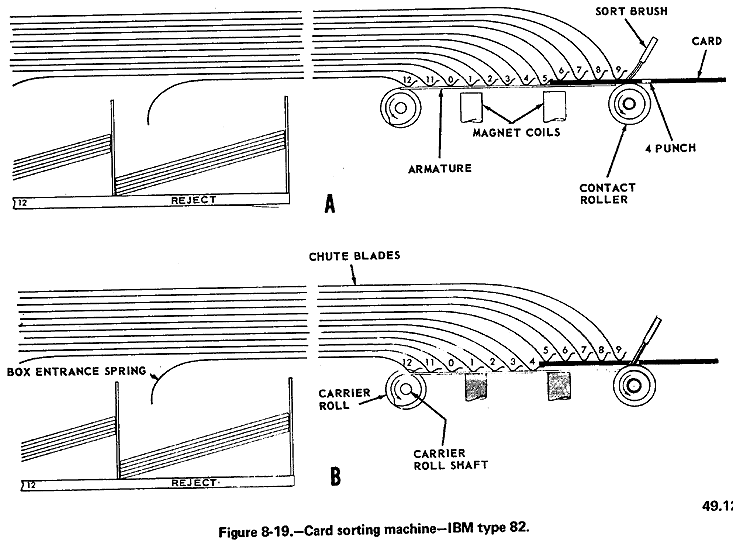Since then I have added material occasionally.
Items are certainly not complete, and may be inaccurate.
Your information, comments, corrections, etc. are eagerly requested.
Send e-mail to Ed Thelen. Please include the URL under discussion. Thank you ***
| Manufacturer | IBM |
| Identification,ID | IBM 083 Sorter |
| Date of first manufacture | - |
| Number produced | - |
| Estimated price or cost | - |
| location in museum | - |
| donor | - |
Contents of this page:
- Photo
- Placard
- Architecture
- Special Features
- Historical Notes
- This Artifact
- Interesting Web Sites
- Other information
|
|
| - |
|
from navy manual "Digital Computer Basics" 1978
Card Sorters ... Card sorters can handle from 500 to 2000 cards per minute (the sorters with the faster rates use photoelectric read systems and vacuum card transports). Card sorters read portions of each card that is passed through them (and in some cases compare certain data on the card with data programmed into the sorter), and then route the cards to separate bins or pockets in accordance with the nature of the data contained on the card. For example, if it is desired to determine the relative seniority of a group of servicemen, punched cards containing extracts of each man's service record can be fed to a card sorter. The sorter can be programmed to read those columns on the card that indicate years of service. The sorter transports the cards indicating 30 years of service into the first bin, 25 years of service into the second bin, etc.
The card sorting process shown in figure 8-19 uses both mechanical and electromechanical principles to perform card sorting. A column selector (not shown) is used to select the column to be read. To understand its operation, assume that it is desired to sort all cards which contain a punch (hole) in the 4's row.
In figure 8-19A, a card (shown as a shaded line in -which the punch in the 4's row is represented as an unshaded area) is advanced beneath a reading brush by a driven roller. The reading process begins at the 9's row (the bottom row of the card) and ends at the 12's row (the top row). While the card is still passing under the reading brush, the leading edge (the bottom) of that card is passing beneath the ends of chute blades. Each of the numbered chute blades terminates in an associated bin (not shown). The ends of the chute blades are supported by a movable armature plate. Figure 8-19B, illustrates how the sorter selects the right chute blade (and therefore the proper bin) for the card. The tips of the chute blades are spaced so that the read brush (also called the "sort brush") drops through the 4-punch in the card immediately after the leading edge of the card passes under the tip of chute blade number 5. The opening in the card permits the brush to make contact with a conductive material beneath the card, thereby closing an electric circuit. The closing of this circuit causes two electro- magnets to be energized. This action exerts sufficient force against a spring tension (which normally holds the armature plate as shown in figure 8-19A) to cause the plate (fig. 8-19B) to move downward. This permits all chute blades beyond the forward end of the card to drop, thus permitting the card to pass into the proper bin. |
| The IBM 083 could sort 1000 cards a minute. That is over 16 cards a second. It was really fun to watch. The excellent card feeder permitted easy addition of cards while machine was running, and skilled operators could remove cards while machine was running. Skilled operators could keep two sorters running full speed for hours. I admired their skill. Beautiful to watch. Even time/motion study folks should admire the show. |
Historical Notes
| - |
This Artifact
| - |
|
|
| - |
If you have comments or suggestions, Send e-mail to Ed Thelen
Go to Antique Computer home page
Go to Visual Storage page
Go to top
Updated December 12, 2001

